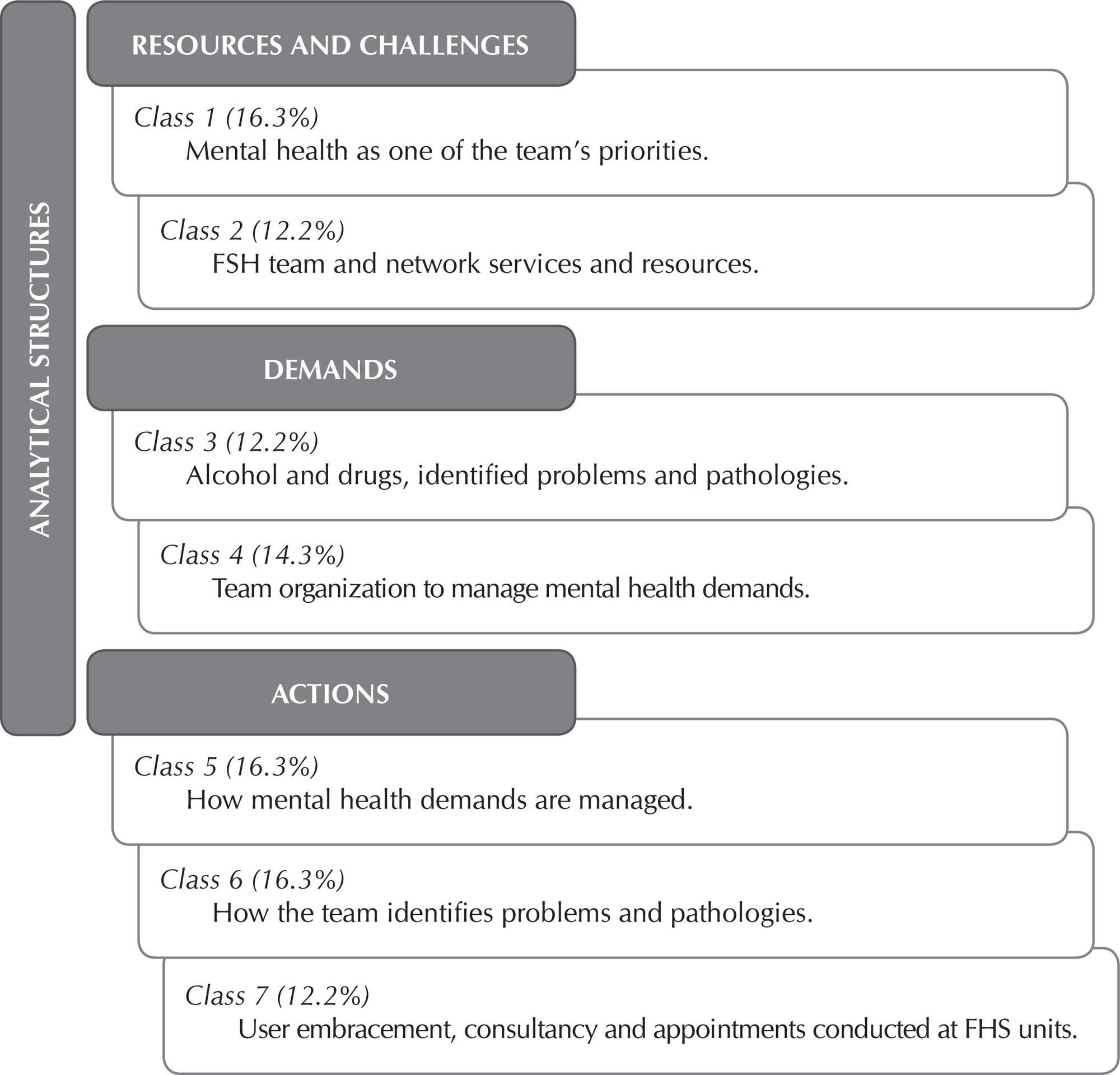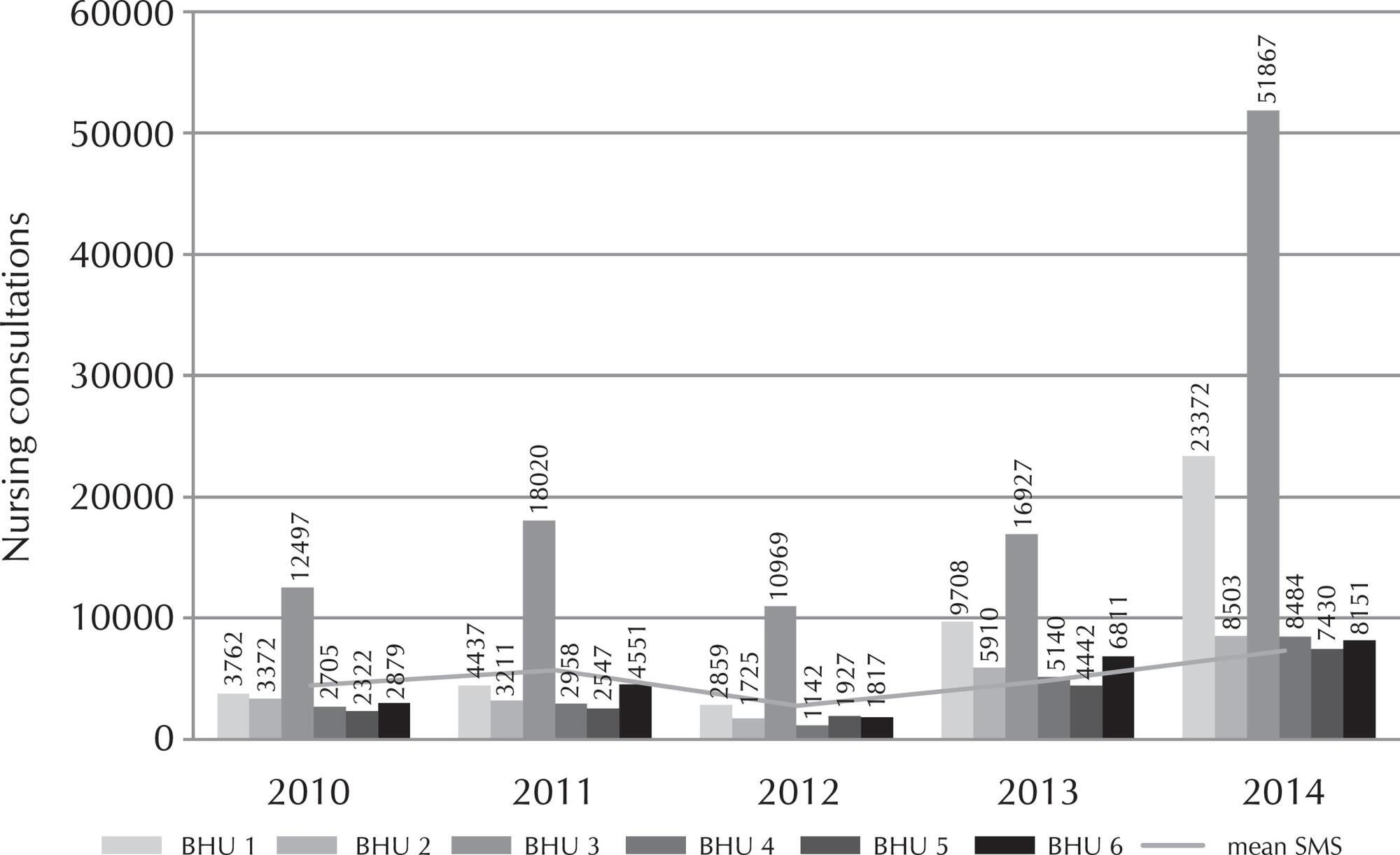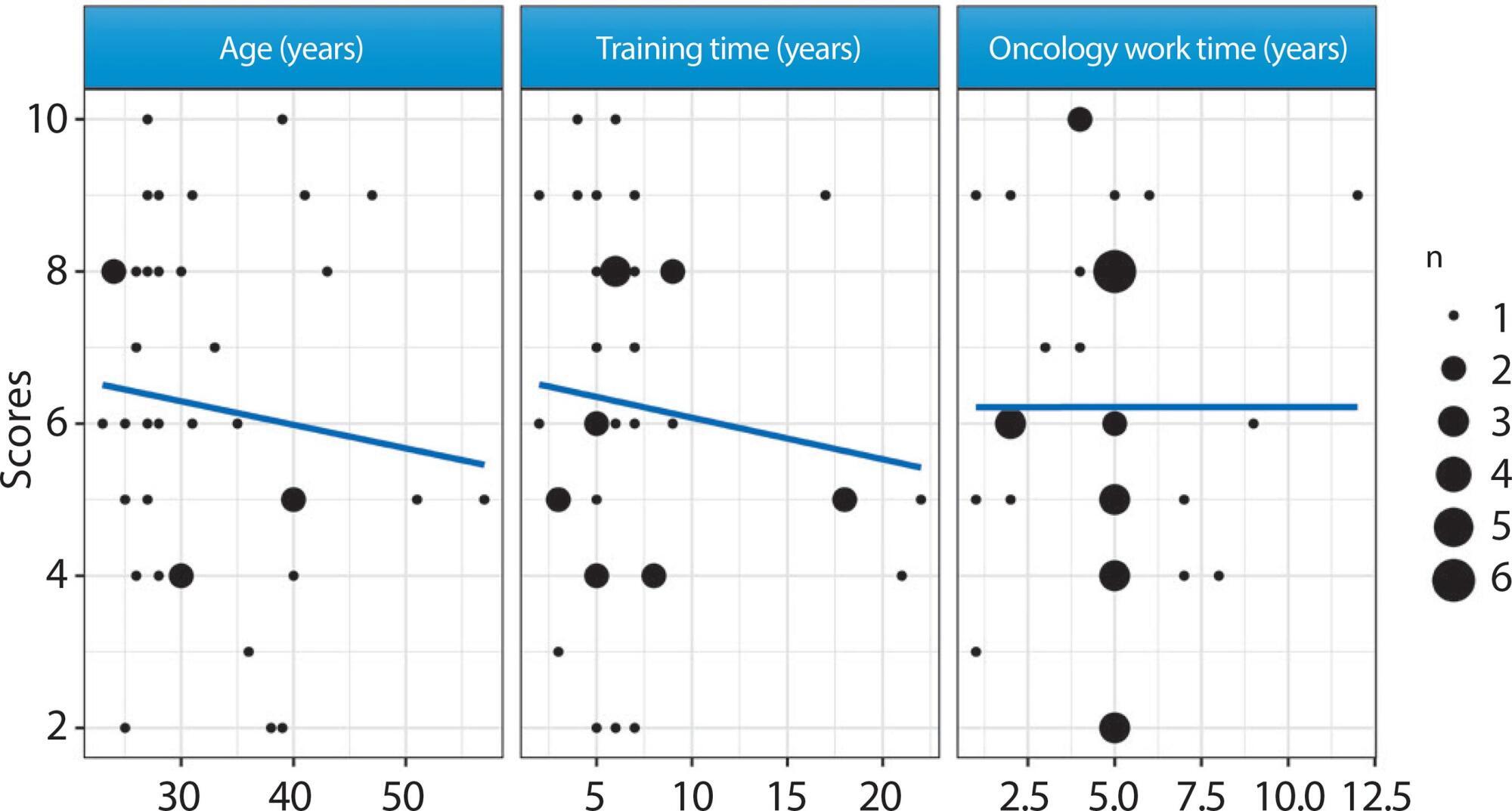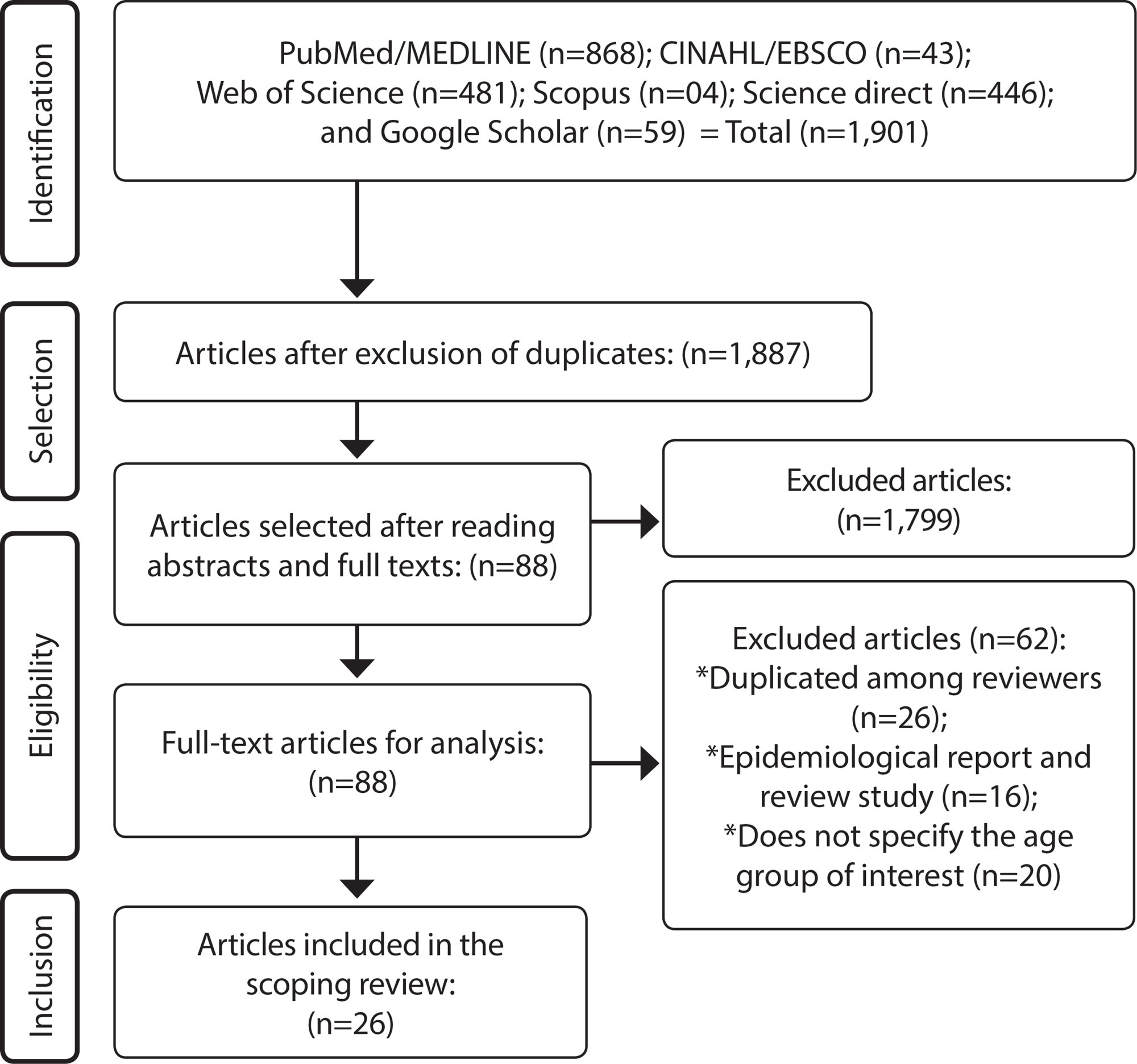-
RESEARCH01-01-2017
Mental health in the Family Health Strategy as perceived by health professionals
Revista Brasileira de Enfermagem. 2017;70(5):935-941
Abstract
RESEARCHMental health in the Family Health Strategy as perceived by health professionals
Revista Brasileira de Enfermagem. 2017;70(5):935-941
DOI 10.1590/0034-7167-2016-0492
Views0See moreABSTRACT
Objective:
to analyze the management of mental health needs in primary care as perceived by Family Health Strategy professionals.
Method:
this was a qualitative descriptive exploratory study developed within the coverage area of five family health teams. The data were collected using observation, group interviews, individual semi-structured interviews, and focus groups. Content analysis was conducted using text analysis software and interpretation was based on the corresponding analytical structures.
Results:
numerous and challenging mental health demands occur in this setting, for which the teams identified care resources; however, they also indicated difficulties, especially related to the operationalization and integration of such resources.
Conclusion:
there is a need for a care network sensitive to mental health demands that are better coordinated and more effectively managed.

-
RESEARCH01-01-2017
Nursing care by telehealth: what is the influence of distance on communication?
Revista Brasileira de Enfermagem. 2017;70(5):928-934
Abstract
RESEARCHNursing care by telehealth: what is the influence of distance on communication?
Revista Brasileira de Enfermagem. 2017;70(5):928-934
DOI 10.1590/0034-7167-2016-0142
Views0See moreABSTRACT
Objective:
Evaluate the perception of nurses regarding interpersonal communication while providing care via telehealth.
Method:
Qualitative research realized with seven nurses working in telehealth in Brazil, the sample was determined by data saturation. A questionnaire with open questions was applied and then content analysis of the dialogues was conducted, focusing on thematic analysis.
Results:
Four categories emerged from the dialogues: Understanding the importance of communication; the interpersonal relationship interfering with communication; Communicating via technology; and Learning the communication process.
Final considerations:
The perception of nurses working in telehealth in Brazil is that technology has facilitated their professional practice; however, in relation to the communication process, they believe it is harder to communicate by telehealth, mainly due to difficulty in perceiving nonverbal signals. To overcome these difficulties, they agreed that interpersonal communication is a skill that must be acquired during their professional training.
-
RESEARCH01-01-2017
Experiences in the Family Health Strategy: demands and vulnerabilities in the territory
Revista Brasileira de Enfermagem. 2017;70(5):920-927
Abstract
RESEARCHExperiences in the Family Health Strategy: demands and vulnerabilities in the territory
Revista Brasileira de Enfermagem. 2017;70(5):920-927
DOI 10.1590/0034-7167-2015-0033
Views0See moreABSTRACT
Objective:
To understand the daily demands of Family Health Strategy in clinical practice of the team and social vulnerabilities of community territory.
Method:
Research with qualitative approach, in a critical-reflexive perspective, held with two teams of the Family Health Strategy, in the city of Fortaleza, State of Ceará, Brazil. The participants were 22 users and 19 health professionals from the basic health network. Data from the interviews and observation were analyzed under the assumptions of critical hermeneutics.
Results:
We highlight the unveiling of sufferings and daily clashes, the influence of social determinants on health and psychosocial demands, limits and possibilities of everyday clinical practice.
Conclusion:
The clinic attention must recognize the perceptions and living conditions by listening and promoting health in the community.
-
RESEARCH01-01-2017
Neoliberalist influences on nursing hospital work process and organization
Revista Brasileira de Enfermagem. 2017;70(5):912-919
Abstract
RESEARCHNeoliberalist influences on nursing hospital work process and organization
Revista Brasileira de Enfermagem. 2017;70(5):912-919
DOI 10.1590/0034-7167-2016-0092
Views0See moreABSTRACT
Objectives:
To describe and analyze the influence of the neoliberal economic and political model on the nursing hospital work process and organization.
Method:
Qualitative descriptive research, having as its scenery a university hospital. The subjects were 34 nursing workers. The data collection took place from March to July 2013, through semi-structured interview. The data treatment technique used was content analysis, which brought up the following category: working conditions precariousness and its consequences to the hospital work process and organization in the neoliberal context.
Results:
The consequences of neoliberalism on hospital work process and organization were highlighted, being observed physical structure, human resources and material inadequacies that harms the assistance quality. In addition to wage decrease that cause the need of second jobs and work overload.
Final considerations:
There is a significant influence of the neoliberal model on hospital work, resulting on working conditions precariousness.
-
RESEARCH01-01-2017
Nursing team’s conceptions about the families of hospitalized children
Revista Brasileira de Enfermagem. 2017;70(5):904-911
Abstract
RESEARCHNursing team’s conceptions about the families of hospitalized children
Revista Brasileira de Enfermagem. 2017;70(5):904-911
DOI 10.1590/0034-7167-2016-0233
Views0See moreABSTRACT
Objectives:
to describe nursing team care and discuss the nursing team’s conception of companion families of hospitalized children. The study was based on the theoretical framework of Collière’s theory of nursing care identity.
Method:
this was a qualitative study with 14 members of a nursing team, conducted through an unstructured group interview. Thematic data analysis was employed.
Results:
habitual and repair care was delegated to families, regardless of the child’s clinical condition.
Final considerations:
the team’s official discourse about the families of hospitalized children, as recommended by the literature, refers to the family’s alterity and participation in care provision, with sights on discharge and defending family participation as beneficial to children. In practice, however, the nursing staff makes concessions about the presence of chaperoning families and delegates care.
-
RESEARCH01-01-2017
Innovation in nursing health care practice: expansion of access in primary health care
Revista Brasileira de Enfermagem. 2017;70(5):898-903
Abstract
RESEARCHInnovation in nursing health care practice: expansion of access in primary health care
Revista Brasileira de Enfermagem. 2017;70(5):898-903
DOI 10.1590/0034-7167-2016-0131
Views0See moreABSTRACT
Objective:
analyze the reorganization of the health care practice of nurses as an innovative strategy for expansion of access in primary care.
Method:
qualitative and quantitative study, which interviewed 32 management and care nurses and collected documentary data from public reports of production of nursing consultations from 2010 to 2014, in a municipality in southern Brazil. Data processing for textual analysis was performed by IRAMUTEQ software; for simple descriptive statistical analysis, the program Excel 2013 was used.
Results:
in the innovative care practice class, associated with awareness of change, related to implementation of the FHS, its challenges and advantages, the following subclasses were identified: reorganization of schedules, nursing consultation, physical restructuring of BHUs, and shared consultation.
Final considerations:
the need to expand access to and valorization of care practice encourages the development of innovative strategies. The protagonism of care needs to be discussed in the various spaces so that each professional carry out the respective role with competence and efficacy.

-
01-01-2017
The Nursing work and the construction of a democratic society
Revista Brasileira de Enfermagem. 2017;70(5):896-897
Abstract
The Nursing work and the construction of a democratic society
Revista Brasileira de Enfermagem. 2017;70(5):896-897
DOI 10.1590/0034-7167.2017700501
Views0In Brazil, the Nursing work is performed by an expressive contingent of workers, which – according to the last survey by the Brazilian Nursing Association – comprised 1,856,683 professionals, mostly women, distributed into three professional categories: Nurses, Nursing Technicians and Nursing Assistants, who work in public and private health care networks. With salaries lower than […]See more -
01-01-2017
O trabalho em Enfermagem e a construção de uma sociedade democrática
Revista Brasileira de Enfermagem. 2017;70(5):896-897
Abstract
O trabalho em Enfermagem e a construção de uma sociedade democrática
Revista Brasileira de Enfermagem. 2017;70(5):896-897
DOI 10.1590/0034-7167.2017700501
Views0No Brasil, o trabalho em enfermagem é realizado por expressivo contingente de trabalhadores, que, de acordo com o último levantamento realizado pela Associação Brasileira de Enfermagem, somava 1.856.683 profissionais, em sua maioria mulheres, distribuído em três categorias profissionais: Enfermeiros, Técnicos e Auxiliares de Enfermagem que atuam na rede pública e privada de saúde. Com baixos […]See more
-
04-14-2021
Child behavior during the social distancing in the COVID-19 pandemic
Revista Brasileira de Enfermagem. 2021;74:e20200762
Abstract
Child behavior during the social distancing in the COVID-19 pandemic
Revista Brasileira de Enfermagem. 2021;74:e20200762
DOI 10.1590/0034-7167-2020-0762
Views0See moreABSTRACT
Objective:
To describe the daily activities performed by children from 6 to 12 years of age incomplete and analyze children’s behavior during social distancing in the face of the COVID-19 pandemic.
Methods:
Cross-sectional study with children in a learning stage living in Brazil. The data were collected via online form. Fisher’s exact test was applied to analyze the association of categorical variables with child behavior; when significant, it was used the odds ratio. It was considered results considered statistically significant those presenting values of p < 0.05.
Results:
Data from 530 children were analyzed: 50.3% female, 71.3% from the Southeast Region, 73% in fulltime social distancing, 52% presented anxiety, which was significantly associated with changes in sleep and appetite.
Conclusion:
The results indicate the need for parents/caretakers to stimulate moments for the child to express themselves, not minimizing their feelings and providing emotional support to mitigate the negative impact of these feelings on the child’s mental and physical health.
-
REFLECTION07-10-2020
Psychosocial risks and the health of health workers: reflections on Brazilian labor reform
Revista Brasileira de Enfermagem. 2020;73:e20190092
Abstract
REFLECTIONPsychosocial risks and the health of health workers: reflections on Brazilian labor reform
Revista Brasileira de Enfermagem. 2020;73:e20190092
DOI 10.1590/0034-7167-2019-0092
Views0See moreABSTRACT
Objective:
to reflect on the psychosocial risks and their impacts on the health of health workers in light of the Brazilian economic context and Labor Reform.
Method:
reflective study on the Brazilian Labor Reform and its impacts on health of health workers.
Results:
although the changes observed in the labor sphere have contributed to improvements in health and safety policies for, these changes have also contributed to the emergence of new risks arising from work activities, including psychosocial risks, which affect all occupational categories.
Final considerations:
we understand that the Brazilian Labor Reform carried out in 2017 leads to the weakening of labor relations, increases workers’ exposure to risks in the workplace, increases the risk of illness, and opposes the global movement of international organizations aimed at the prevention of aggravation in workers’ health and also at preserving their health.
-
ORIGINAL ARTICLE03-30-2020
Best Safety Practices in nursing care in Neonatal Intensive Therapy
Revista Brasileira de Enfermagem. 2020;73(2):e20180482
Abstract
ORIGINAL ARTICLEBest Safety Practices in nursing care in Neonatal Intensive Therapy
Revista Brasileira de Enfermagem. 2020;73(2):e20180482
DOI 10.1590/0034-7167-2018-0482
Views0See moreABSTRACT
Objectives:
to identify the perception of nursing professionals on human errors in nursing care at a Neonatal Intensive Care Unit and to assess Best Practices strategies proposed by these professionals for patient safety in nursing care.
Methods:
this is a quantitative-qualitative, descriptive study. Setting: Neonatal Intensive Care Unit. Participants: 22 nursing professionals. Data collection was performed through interviews and sent to the thematic analysis.
Results:
human errors in nursing care, such as wasted catheters; errors in the medication process; causes for error in nursing care, with a focus on work overload; Best Practices for patient safety in nursing care, such as professional training and improved working conditions.
Conclusions:
it is of utmost importance to invest in Best Practices strategies for Patient Safety, aimed at consolidating the culture of organizational safety and encouraging an adequate environment to manage errors.
-
ORIGINAL ARTICLE02-10-2020
Nursing team knowledge on care for patients with fungating wounds
Revista Brasileira de Enfermagem. 2020;73(1):e20170738
Abstract
ORIGINAL ARTICLENursing team knowledge on care for patients with fungating wounds
Revista Brasileira de Enfermagem. 2020;73(1):e20170738
DOI 10.1590/0034-7167-2017-0738
Views0See moreABSTRACT
Objective:
to evaluate the nursing team knowledge of a cancer hospital on care for patients with Malignant Fungating Wounds (MFW) and to analyze associated sociodemographic and educational factors.
Method:
an observational and cross-sectional study, conducted between September and October 2015, after approval by the Research Ethics Committee. A questionnaire was applied containing sociodemographic, educational and related components to the accomplishment of dressings, dressings choice and orientation. Data were analyzed by using Chi-square, Fisher’s exact test, Student’s t-Test and Pearson’s correlation.
Results:
37 professionals participated in the study, most of whom were technicians (56.8%), women (91.9%) and with a mean age of 32 years. The professionals presented 56.5% of correct answers. There were no statistically significant associations between sociodemographic/educational variables and number of correct answers.
Conclusion:
there was a lack of important knowledge about care for patients with MFW, which should guide strategies for the oncology staff training.

-
ORIGINAL ARTICLE08-07-2020
Quality of life of high risk pregnant women during prenatal care
Revista Brasileira de Enfermagem. 2020;73:e20190595
Abstract
ORIGINAL ARTICLEQuality of life of high risk pregnant women during prenatal care
Revista Brasileira de Enfermagem. 2020;73:e20190595
DOI 10.1590/0034-7167-2019-0595
Views0See moreABSTRACT
Objective:
to analyze the quality of life of high-risk pregnant women.
Methods:
an observational and cross-sectional study, carried out in a tertiary maternity hospital located in Fortaleza, with 276 high-risk pregnant women. A questionnaire was applied containing socioddemographic, clinical and obstetric data and The Mother-Generated Index. Descriptive analyzes were performed using the Jamovi statistical program®, version 0.9.
Results:
most areas were negatively influenced by pregnancy. “Satisfaction with pregnancy”, “family relationship” and “relationship with the partner” obtained the highest means of primary score, while “physical condition/disposition” and “financing” obtained the lowest means. The highest secondary scores were in “satisfaction with pregnancy”, “family relationship” and “relationship with the partner”, while the lowest were in “financing” and “psychological/emotional”.
Conclusion:
the total primary score mean was 6.03, suggesting a good quality of life. The Mother Generated Index made it possible to identify aspects of life that go beyond pre-formulated assessments of the construct.
-
REFLECTION02-10-2020
Effectiveness of clinical surface cleaning and disinfection: evaluation methods
Revista Brasileira de Enfermagem. 2020;73(1):e20180623
Abstract
REFLECTIONEffectiveness of clinical surface cleaning and disinfection: evaluation methods
Revista Brasileira de Enfermagem. 2020;73(1):e20180623
DOI 10.1590/0034-7167-2018-0623
Views0See moreABSTRACT
Objective:
To discuss the methods employed to evaluate the effectiveness of clinical surface cleaning and disinfection (C&D).
Method:
This is a theoretical reflection based on scientific studies and the experience of the authors. Knowledge and current gaps, the need for further studies, and practical application of the methods were approached.
Results:
There are four main methods used to evaluate the effectiveness of clinical surface C&D: visual inspection, fluorescent markers, microbiological cultures, and adenosine triphosphate (ATP) bioluminescence. The first two are used to evaluate the process and to predict adherence to protocols by the staff, and the last two are employed to evaluate the results, therefore being the most relevant to assess the risk of infection.
Final considerations:
The ideal method was not found, because all of them showed limitations. There is a need for strategies to optimize the precision of these methods.
-
ORIGINAL ARTICLE03-09-2020
Quality of life at work in a central sterile processing department
Revista Brasileira de Enfermagem. 2020;73(2):e20180792
Abstract
ORIGINAL ARTICLEQuality of life at work in a central sterile processing department
Revista Brasileira de Enfermagem. 2020;73(2):e20180792
DOI 10.1590/0034-7167-2018-0792
Views1See moreABSTRACT
Objectives:
to evaluate the quality of life of nursing professionals who work in a central sterile processing department.
Methods:
a descriptive, quantitative, exploratory study, conducted with 82 nursing professionals working in the Central Sterile Processing Department of a University Hospital, from September to November 2017. A semi-structured instrument and the questionnaire “Medical Outcomes Study Short-Form 36” were used. Results: most of the participants were female, married, aged 31-40 years; 47.6% with 6-10 years of profession, and 82.9% reported working in CSPD for 1-5 years. The most affected quality of life domains were Pain, Vitality, General Health Status and Social Aspects.
Conclusions:
This study showed a need for rethinking and re-creating the labor dynamics in CSPD to improve the quality of life of these nursing professionals.
-
REVIEW01-29-2021
Epidemiological profile of children and adolescents with COVID-19: a scoping review
Revista Brasileira de Enfermagem. 2021;74:e20200624
Abstract
REVIEWEpidemiological profile of children and adolescents with COVID-19: a scoping review
Revista Brasileira de Enfermagem. 2021;74:e20200624
DOI 10.1590/0034-7167-2020-0624
Views0See moreABSTRACT
Objective:
to map the epidemiological profile of children and adolescents with COVID-19 in the world literature.
Methods:
a scoping review systematized by the Joanna Briggs Institute protocol in the PubMed/MEDLINE, CINAHL, Web of Science, Scopus, Science direct and Google Scholar databases. Articles with children and/or adolescents with laboratory diagnosis of COVID-19 were used.
Results:
thirty-two articles were included in the review. Most children and adolescents were male, with contamination by family transmission. The most frequent clinical manifestations were fever, cough and diarrhea. Ten studies cited pre-existing condition/disease, and hospital length ranged from one to twenty days. Three deaths were reported and no study presented race/color, education and socioeconomic conditions.
Conclusion:
it was possible to screen the epidemiological profile with information about age group, sex, probable contamination of the disease, clinical manifestations, presence of pre-existing disease/condition, hospitalization and deaths among children and adolescents with COVID-19.

Search
Search in:
Nuvem de Tags
Adolescente (85) Atenção Primária à Saúde (239) COVID-19 (91) Criança (91) Cuidados de Enfermagem (269) Educação em Enfermagem (151) Educação em Saúde (139) Enfermagem (930) Enfermagem Pediátrica (86) Estudantes de Enfermagem (77) Estudos de Validação (131) Família (87) Idoso (208) Promoção da Saúde (99) Qualidade de Vida (104) Saúde do Trabalhador (86) Saúde Mental (145) Saúde Pública (82) Segurança do Paciente (150) Tecnologia Educacional (100)



